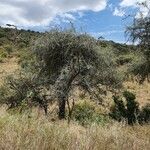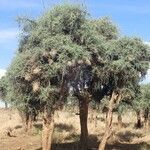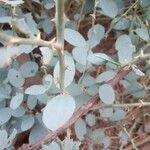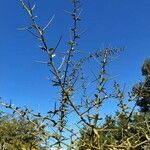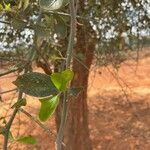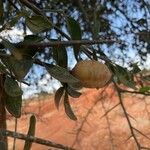A small evergreen tree. It grows up to 6-15 m high. It is spiny. It produces a rounded crown of tangled thorny branches. The bark is dark brown or grey and has patterns on it. It becomes corky and cracked with age. The branches are stiff and brittle. The branches have stout spines. They are single and 8 cm long. The thorns are soft at first then become woody. The leaves occur as distinctive pairs of grey-green leaflets. The leaves are 2.5-6 cm long by 1.5-4 cm wide. The leaves are slightly different shape in each half. They are leathery and slightly hairy. There are 4-6 prominent veins which are clearly seen on the under side of the leaf. The flowers are in clusters, small and hairy. They are 1.4 cm across. They are yellow-green and have a sweet smell. The fruit is yellowish-green and 5 cm long by 2.5 cm wide. The fruit are date like. Both ends of the fruit are rounded. There is a hard pointy seed about 4 cm long by 2 cm wide. The flesh around the seed is yellow and bittersweet. The seed is easily separated from the flesh.
Leaves petiolate; leaflets shortly petiolulate; lamina 2·5–6 × 1·5–4 cm., slightly asymmetric, elliptic to elliptic-obovate, apex subacute to obtuse, sometimes slightly refuse, base cuneate or rarely rounded, coriaceous, puberulous when young, later glabrescent or sometimes remaining puberulous on the lower surface; secondary nerves 4–6 pairs, ± prominent beneath; petiole (0·5) 0·8–2 cm. long, puberulous or glabrescent, canaliculate.
Small evergreen tree (rarely a shrub) up to 15 m. high, ± spiny, with a flat or rounded crown; stem with a reticulate dark brown or grey (rarely green) bark; branches green or greyish, stiff and brittle, always armed with stout simple green or yellowish spines.
Drupe yellowish or green, up to 5 × 2·5 cm., usually subcylindric, more rarely narrowly ellipsoid or subobclavate, finely puberulous, sometimes glabrescent.
Sepals 5·2–7 × 2·7–3·25 mm., ovate or ovate-lanceolate, coriaceous, caducous, densely pubescent outside, with long silky whitish hairs inside.
Flowers in usually few-flowered sessile or shortly pedunculate fascicles; pedicels up to 1·5 cm. long, ± densely greyish-pubescent.
Petals 7·2–9·5 × 2–2·4 (2·8) mm., narrowly elliptic or elliptic-oblong, rarely lanceolate-oblong, glabrous on both surfaces.
Stamens with the anthers 1·7–2·2 mm. long, ovate or ovate-oblong, glabrous; filaments c. 3·75 mm. long.
Ovary densely covered with long silky hairs.
Flowers c. 1·4 cm. in diam.
